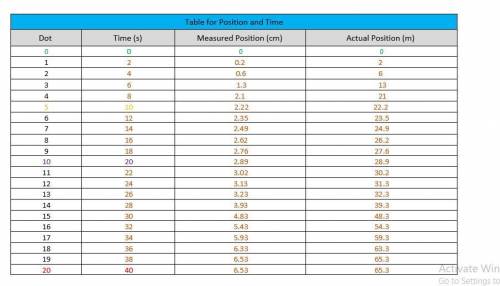
Physics, 10.11.2021 18:40 delaneyjane1599
4. Plot a graph of (actual) position vs time using the data in the table above. The graph must have the correct labels for the title, axes, and units. You can plot it by hand on graph paper, or take a picture and paste it here. (Alternatively, you could also use Microsoft Excel to generate the graph and paste that chart here.)
5. Using the position–time graph, calculate the velocity of the formula 1 for the time period when the velocity is constant. Please show your calculation and answer below. (Hint: between 10 and 20 seconds).
6. Using the data from step 4 and the fact that the car started from rest at zero seconds and came to rest at 40 seconds, Plot the corresponding velocity-time graph for the motion of the Formula 1 car. The graph must have the correct labels for the title, axes, and units. You can plot it by hand on graph paper, or take a picture and paste it here. (Alternatively, you could also use Microsoft Excel to generate the graph and paste that chart here.)
7. Using the velocity-time graph, calculate the acceleration of the Formula 1 car for the time period when the Formula 1 car has positive acceleration. Please show your calculation and answer below.
8. Using the velocity-time graph, calculate the acceleration of the Formula 1 car for the time period when the Formula 1 car has negative acceleration. Please show your calculation and answer below.
9. Plot the corresponding acceleration-time graph for the motion of the Formula 1 car. The graph must have the correct labels for the title, axes, and units. You can plot it by hand on graph paper, or take a picture and paste it here. (Alternatively, you could also use Microsoft Excel to generate the graph and paste that chart here.)


Answers: 2
Another question on Physics

Physics, 22.06.2019 01:30
Question 7 [2 marks] in the circuit below, the electromotive force generated by the battery is e = 6.0 v, and the resistances are r1 = r4 = 1.0 q, r2 = r3 =2.0 q. r. the power delivered by the battery to the circuit is closest to a. 6 w в. 12 w с. 15 w d. 18 w e. 20 w final exam autumn 2014 page 5 of 9 68037 physical modelling faculty of science [2 mark] question 8 with reference to question 7, the current through resistor r2 is closest to a. 1 a в. 2 а c. 3 a d. 4 a e. 6 a
Answers: 2

Physics, 22.06.2019 13:10
The atoms in a nickel crystal vibrate as harmonic oscillators with an angular frequency of 2.3 × 1013 rad/s. the mass of a nickel atom is 9.75 × 10-26 kg. what is the difference in energy between adjacent vibrational energy levels of nickel? (h = 6.626 × 10-34 j • s, , 1 ev = 1.60 × 10-19 j)
Answers: 2

Physics, 22.06.2019 14:20
A1-lb collar is attached to a spring and slides without friction along a circular rod in a vertical plane. the spring has an undeformed length of 5 in. and a constant k =25 lb/ft. knowing that the collar is released from being held at a determine, the speed of the collar and the normal force between the collar and the rod as the collar passes through b.
Answers: 3

Physics, 22.06.2019 14:30
Suppose that 27 j of work is needed to stretch a spring from its natural length of 6 m to a length of 9 m. (a) how much work is needed to stretch the spring from 12 m to 14 m? j (b) how far beyond its natural length will a force of 78 n keep the spring stretched?
Answers: 2
You know the right answer?
4. Plot a graph of (actual) position vs time using the data in the table above. The graph must have...
Questions

Biology, 07.06.2021 03:50


Mathematics, 07.06.2021 03:50



Mathematics, 07.06.2021 03:50

Spanish, 07.06.2021 03:50





Spanish, 07.06.2021 04:00


Mathematics, 07.06.2021 04:00



Computers and Technology, 07.06.2021 04:00



Mathematics, 07.06.2021 04:00



